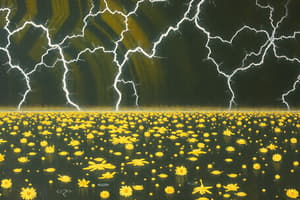Podcast
Questions and Answers
What does the Coulomb's Law formula express?
What does the Coulomb's Law formula express?
- The conservation of electric charge in a system.
- The relationship between charge and electric field.
- The force between two charges dependent on their distance. (correct)
- The potential difference across a capacitor.
Which materials are classified as conductors?
Which materials are classified as conductors?
- Copper and aluminum. (correct)
- Air and vacuum.
- Wood and fabric.
- Rubber and glass.
What does the electric field vector (E) represent?
What does the electric field vector (E) represent?
- The force experienced by a positive charge. (correct)
- The charge distribution within a conductor.
- The potential energy of charges in a field.
- The total charge within a closed surface.
What is the correct unit for measuring electric potential?
What is the correct unit for measuring electric potential?
How is electric charge conserved in a closed system?
How is electric charge conserved in a closed system?
Which of the following best describes the method of charging by induction?
Which of the following best describes the method of charging by induction?
What does the formula for capacitance (C = Q/V) represent?
What does the formula for capacitance (C = Q/V) represent?
What is the effect of distance on the forces between two charges according to Coulomb's Law?
What is the effect of distance on the forces between two charges according to Coulomb's Law?
Which statement correctly describes the attraction or repulsion between charges?
Which statement correctly describes the attraction or repulsion between charges?
How does the electric field behave as it moves away from a charge?
How does the electric field behave as it moves away from a charge?
Flashcards are hidden until you start studying
Study Notes
Concepts de base de l'électrostatique
- Définition : Étude des charges électriques au repos et des forces qui agissent entre elles.
- Charges électriques : Deux types - positives (protons) et négatives (électrons).
- Loi de Coulomb : La force entre deux charges est directement proportionnelle au produit des charges et inversement proportionnelle au carré de la distance entre elles.
- Formule : F = k * |q1 * q2| / r²
- k = constante de Coulomb (8.99 x 10^9 N m²/C²)
Propriétés des charges
- Conservation de la charge : La charge totale d'un système reste constante.
- Polarité : Charges opposées s'attirent, charges identiques se repoussent.
- Conducteurs vs. Isolants :
- Conducteurs : Matériaux permettant le mouvement des charges (ex. métaux).
- Isolants : Matériaux empêchant le mouvement des charges (ex. caoutchouc).
Champ électrique
- Définition : Région autour d'une charge où une autre charge ressent une force.
- Vecteur champ électrique (E) : Direction de la force sur une charge positive.
- Formule : E = F/q
- Lignes de champ : Représentent la direction et l'intensité du champ (éloignées pour un champ plus faible).
Potentiel électrique
- Définition : Travail nécessaire pour amener une charge unitaire d’un point de référence à un point donné.
- Unité : Volt (V)
- Différence de potentiel : Mesure de l'énergie par unité de charge entre deux points.
Loi de Gauss
- Énoncé : Le flux électrique à travers une surface fermée est proportionnel à la charge totale à l'intérieur de cette surface.
- Application : Permet de calculer les champs électriques pour des distributions de charges symétriques.
Applications de l'électrostatique
- Condensateurs : Dispositifs stockant l'énergie sous forme de champ électrique.
- Caractérisés par leur capacité (C = Q/V).
- Électrostatique en physique et ingénierie : Utilisée dans des technologies comme l'électronique, l'imagerie par résonance magnétique (IRM) et le purification de l'air.
Électrisation
- Méthodes :
- Par contact : Transfert direct des charges.
- Par induction : Redistribution des charges sans contact direct.
- Par friction : Échange de charges entre deux matériaux en contact.
Forces électrostatiques
- Force de répulsion/attraction : Dépend de la nature des charges (positives vs. négatives).
- Superposition des forces : Les forces sur une charge donnée résultent de la somme vectorielle des forces individuelles exercées par d'autres charges.
Concepts avancés
- Énergie potentielle électrostatique : Énergie due à la position d'une charge dans un champ électrique, donnée par U = k * q1 * q2 / r.
- Dipôle électrique : Configuration de charges opposées séparées par une distance, avec un moment dipolaire p = q * d.
Ces notes résument les concepts clés de l'électrostatique, fournissant une base pour des études plus approfondies.
Electrostatics: Basic Concepts
- Definition: The study of stationary electric charges and the forces they exert on one another.
- Electric Charges: Two types: positive (protons) and negative (electrons).
- Coulomb's Law: Defines the force between two charges: directly proportional to the product of the charges and inversely proportional to the square of the distance between them.
- Formula: F = k * |q1 * q2| / r²
- k is Coulomb's constant (8.99 x 10^9 N m²/C²)
Properties of Charges
- Conservation of Charge: The total charge of a system remains constant.
- Polarity: Opposite charges attract, like charges repel.
- Conductors vs. Insulators:
- Conductors: Materials that allow the movement of charges (e.g., metals).
- Insulators: Materials that prevent the movement of charges (e.g., rubber).
Electric Field
- Definition: The region surrounding an electric charge where another charge would experience a force.
- Electric Field Vector (E): Indicates the direction of the force on a positive charge.
- Formula: E = F/q
- Field Lines: Represent the direction and intensity of the field (lines further apart indicate a weaker field).
Electric Potential
- Definition: The work required to bring a unit positive charge from a reference point to a given point.
- Unit: Volt (V)
- Potential Difference: Measures the energy per unit charge between two points.
Gauss's Law
- Statement: The electric flux through a closed surface is proportional to the total charge enclosed within that surface.
- Application: Useful for calculating electric fields for symmetric charge distributions.
Applications of Electrostatics
- Capacitors: Devices that store energy in the form of an electric field.
- Characterized by their capacitance (C = Q/V).
- Electrostatics in Physics and Engineering: Applied in technologies like electronics, magnetic resonance imaging (MRI), and air purification.
Electrification
- Methods:
- Contact: Direct transfer of charges.
- Induction: Redistribution of charges without direct contact.
- Friction: Exchange of charges between two materials in contact.
Electrostatic Forces
- Repulsion/Attraction: Depends on the nature of the charges (positive vs. negative).
- Superposition of Forces: The net force on a given charge is the vector sum of individual forces exerted by other charges.
Advanced Concepts
- Electrostatic Potential Energy: Energy due to the position of a charge in an electric field, given by U = k * q1 * q2 / r.
- Electric Dipole: Configuration of opposite charges separated by a distance, with a dipole moment p = q * d.
Studying That Suits You
Use AI to generate personalized quizzes and flashcards to suit your learning preferences.




